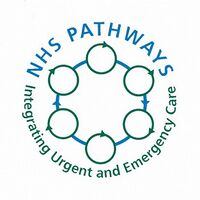Medicine:NHS Pathways
 | |
| Developer(s) | NHS Digital |
|---|---|
| Stable release | April 2021 (25.2.0)
/ NHS Pathways Update: V25 |
| Operating system | Microsoft Windows |
| Website | digital |
NHS Pathways is a triage software utilised by the National Health Service of England to triage public telephone calls for medical care and emergency medical services – such as 999 or 111 calls – in some NHS trusts and five of the ambulance services in the country.[1][2] In its emergency capacity, it has replaced the Advanced Medical Priority Dispatch System for some trusts, and in non-emergency telephone triage it is found in many medical care triage systems, such as NHS 111.[3]
The system, born from a desire to reduce unnecessary call-outs for emergency services, and to reduce the instances of patients rebounding between care providers due to repeated re-triage, is designed to triage any health problem and refer to the appropriate service either within or without the service undertaking the triage. With an attached Capacity Management System, NHS Pathways is designed to factor in what services are available local to the patient when supplying care provision. In essence, the intention is that any health care problem can be triaged by any arm of the NHS – emergency or non-emergency – and can be directed to any possible health care provider without the need for a second triage on referral, or any delay.[1]
Mechanism of triage
As with many triage systems, NHS Pathways operates on a diagnosis of exclusion, excluding conditions based on a set of triage questions developed by senior clinicians at NHS Digital. Upon arriving at an illness or injury that cannot be excluded, the system directs the patient to the appropriate level of care for that condition. Theoretically, patients will receive a higher level of care than their actual condition warrants on occasion, but should never receive a lower level.[4] Unlike previous triage systems, in an emergency capacity NHS Pathways can lead the patient to doctor, nurse, emergency department, or home-care advice dispositions, whereas previous systems often merely led to various levels of ambulance response.[5] The lack of such care providers in an area also highlights gaps in services for the NHS to review.[6]
Current usage
NHS Pathways is currently utilised in nine of the eleven English ambulance services:[1]
- North East Ambulance Service 999 and 111
- South Western Ambulance Service 111
- South East Coast Ambulance Service 999 and 111
- West Midlands Ambulance Service 999
- Isle of Wight NHS Trust 999 and 111
- South Central Ambulance Service 999 and 111
- North West Ambulance Service 111
- Yorkshire Ambulance Service 111
- London Ambulance Service 111
In addition, there are numerous non-ambulance operated NHS 111 providers, including: Partnering Health Limited (PHL), Vocare, Care UK, Primecare, IC24, Derbyshire Health United, Herts Urgent Care and a number of GP out-of-hours co-operatives.
History
NHS Pathways evolved following reports by the National Audit Office (NAO) into the inconsistency of 'hear and treat' statistics across the ambulance services of the United Kingdom. In June 2011 it was approved by the NAO "as a way to make substantial savings and improve efficiency in ambulance services."[7] Its development was intended to coincide with – and be integrated into – the growth of the new non-emergency healthcare system NHS 111.[8] By October 2011, the Department of Health announced plans to extend NHS 111 – and Pathways – across the UK by 2013 to replace NHS Direct.[9] Its role in emergency medicience received media coverage from the BBC that focused on the hope that it would reduce unnecessary ambulance dispatches as an improvement on the existing AMPDS or criteria-based dispatch systems. The North East Ambulance Service, already using NHS Pathways, declared that it reduced such call outs by 2,000 per month.[10] Using an attached capacity management system (CMS) NHS Pathways can analyse the medical services local to each caller, and thus direct the patient to nearby minor injury units or doctor's surgeries depending on the presenting condition. The NHS launched Pathways with the example of an adult female with an arm laceration who – upon being triaged by NHS Pathways via NHS 111 – was directed to a minor injuries unit one mile from her home that was identified by the CMS function of NHS Pathways as being suitable. In theory, any patient with any medical condition can contact any telephone-based medical care provider (999, NHS 111, out-of-hours GP) and be directed to any care pathway, be it ambulance, doctor, nurse, or emergency department, using one system.[11]
Notes
- ↑ 1.0 1.1 1.2 "NHS Pathways". NHS Connecting for Health. http://www.connectingforhealth.nhs.uk/systemsandservices/pathways. Retrieved 2013-06-05.
- ↑ "For Ambulance Services". Connecting for Health. http://www.connectingforhealth.nhs.uk/systemsandservices/pathways/forambulance. Retrieved 2013-06-05.
- ↑ "Deployment map: overall NHS Pathways coverage". NHS Connecting for Health. http://www.connectingforhealth.nhs.uk/systemsandservices/pathways/map. Retrieved 2013-06-05.
- ↑ "Frequently Asked Questions - How do you ensure that the questions within NHS Pathways will be used to successfully diagnose particular illnesses?". Connecting for Health. http://www.connectingforhealth.nhs.uk/systemsandservices/pathways/faqs. Retrieved 2013-06-05.
- ↑ "NHS Pathways - Integrating Urgent and Emergency Care" (Press release). National Health Service Clinical Directorate. May 10, 2011. Retrieved 2013-06-06.
- ↑ "For commissioners". Connecting for Health. http://www.connectingforhealth.nhs.uk/systemsandservices/pathways/info. Retrieved 2013-06-05.
- ↑ "NAO report supports the use of NHS Pathways". Connecting for Health. http://www.connectingforhealth.nhs.uk/systemsandservices/pathways/news/naoreport. Retrieved 2013-06-05.
- ↑ "The 111 number for urgent help". Connecting for Health. http://www.connectingforhealth.nhs.uk/systemsandservices/pathways/news/111number. Retrieved 2013-06-05.
- ↑ Laja, Sade (2011-10-03). "Department of Health announces 111 phone and web plans". The Guardian (London). https://www.theguardian.com/healthcare-network/2011/oct/03/department-health-111-phone-web-plans?INTCMP=SRCH. Retrieved 2013-06-05.
- ↑ "NHS Pathways features on BBC Inside Out". Connecting for Health. http://www.connectingforhealth.nhs.uk/newsroom/news/insideout. Retrieved 2013-06-05.
- ↑ "How does NHS Pathways work?". Connecting for Health. http://www.connectingforhealth.nhs.uk/systemsandservices/pathways/about/how. Retrieved 2013-06-05.
References
- "NHS Pathways - Integrating Urgent and Emergency Care" (Press release). National Health Service Clinical Directorate. May 10, 2011. Retrieved 2013-06-06.

